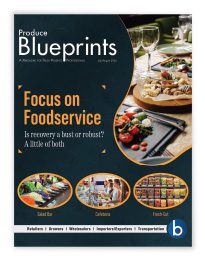Agribusiness has seen an increased concentration in the number of participating businesses over the past 30 years, according to a recent study by USDA’s Economic Research Service (ERS).
The study focuses on three sectors: seed companies, meatpacking, and retail grocery. Of these, the first two deal with the produce industry for the most part indirectly.

The discussion of mergers and acquisitions in seed companies focus heavily on the major commodity crops, although the study notes, “Among vegetable crops . . . European seed companies like Rijk Zwaan and Enza Zaden may hold a dominant share for certain species.”
One striking trend was the increased prevalence of genetically modified (GM) crops in American agriculture. In addition to the major commodity crops, they “have been planted on a commercial scale in potato, papaya, squash, and apples. . . . By 2020, about 55 percent of the total harvested cropland in the United States was grown with varieties having at least one GM trait. The most prevalent GM traits are herbicide tolerance and insect resistance.”
As for grocery, “food retail concentration has been growing with nationwide CR4 rating rising from 13 percent in 1990 to 34 percent by 2019.” (The CR4 figure indicates what percentage of the sector is dominated by the four largest participants.)
Although increased consolidation tends to be anticompetitive (raising prices for consumers), this didn’t prove to be the case in retail grocery. The study discussed the price impact of 14 grocery mergers between 2004 and 2009. It turned out that “5 of the 14 mergers resulted in estimated price increases of more than 2 percent. Five other mergers resulted in price decreases of over 2 percent, and the remaining four mergers generated no significant price changes.”
It turns out that “retail grocery chains do not adjust prices in response to the local competitive landscape. . . . Retail chains alter prices in specific store in response to changes in local cost (such as shipping cost or excise taxes), but do not vary prices in response to local demand changes.”
Instead, retail groceries tend to rely on “simple, ‘rule of thumb’ cost-plus pricing strategies, where retailers ignore local demand conditions and focus on costs instead.”
One interesting finding: “The large-scale mergers of recent years—creating the modern Kroger, Albertsons, and Ahold-Delhaize chains—largely served to combine firms that did not directly compete with one another because they operated in different parts of the country.”
As for the issue of largest concern to the produce industry—whether retail consolidation will lead to monopsony, whereby one or very few buyers control the market—the study said, “While national retail concentrating is increasing, the current level (CR4 of 34) is not one that indicates competitive concern, even before consideration of the additional buyer competition provided by foodservice and export buyers.”
The study is limited to current and past conditions, so it does not touch upon issues such as the highly controversial proposed Kroger-Albertsons merger. But if its conclusions are to be taken seriously, concerns about retail monopsony aren’t justified—at least not yet.



